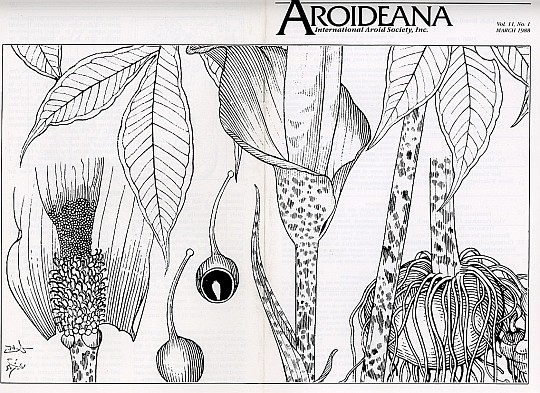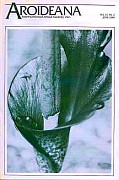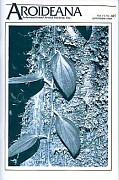|
|



Your search for articles published in volume 11 has found 16 articles.

|

| 
| 
|
Articles of 3 pages or less are available for free to IAS members for download, and longer articles for $5. Articles from issues in 2016 and beyond are only available electronically, and are free to current members when they are logged in.
Please remember that all Aroideana articles are protected by copyright, and you may NOT distribute even electronic copies without permission from the authors or editor.
(Issue) |
||||
| Li Hen, Long Chun-lin | New taxa of Amorphophallus from China (Buy) | |||
| ABSTRACT: Amorphophallus pingbianensis H. Li et C. L. Long, sp. nov. and Amorphophallus nanus H. Li et C. L. Long, sp. nov. are described. | ||||
| Chris A. C. Okonkwo | 'Anyamanya' Cocoyam
This article available FREE to IAS Members with a PERSONAL login. LOGIN, REGISTER or JOIN | |||
| ABSTRACT: Taro, one of the edible cocoyams, is a major root crop of tropical countries. 'Anyamanya' appears to be a new mutant varie ty. 'Anyamanya' is fairly resistant to Sclerotium rolfsii, the causative organism of cocoyam rot disease; flowers naturally under field conditions in one growing season; has a high multiplication ratio and quicker crop establishment; and probably contains little or no calcium oxalate crystals. | ||||
| Jack Craig | Aglaonemas of Indonesia
This article available FREE to IAS Members with a PERSONAL login. LOGIN, REGISTER or JOIN | |||
| ABSTRACT: Observations about Aglaonemas in Indonesia are based upon numerous trips to the Botanic Gardens of Bogor and its satellite gardens, as well as the gardens of collectors in the Djakarta and Surabaya area. | ||||
| Anonymous | Photograph: Cyrtosperma cuspidispathum Alderwer from Indonesia
This article available FREE to IAS Members with a PERSONAL login. LOGIN, REGISTER or JOIN | |||
| Alistair Hay | Amorphophallus (Araceae) in Australasia (Buy) | |||
| ABSTRACT: Amorphophallus galbra F. M. Bailey is recorded from New Guinea for the first time. A. angustilobus F. M. Bailey is a synonym. A. variabilis Bl. is noted from the Tanimbar Islands. | ||||
| Anonymous | Photograph: Anchomanes nigritianus from West Africa
This article available FREE to IAS Members with a PERSONAL login. LOGIN, REGISTER or JOIN | |||
| Hans Visser | A big aroid
This article available FREE to IAS Members with a PERSONAL login. LOGIN, REGISTER or JOIN | |||
| ABSTRACT: Two years ago I received some seeds of Colocasia gigantea. The seeds came from a good friend of mine who also has an aroid collection. A big difference between our collections is that he can grow his plants outdoors. | ||||
| Craig Phillips | Some tips on totems and wire hangers
This article available FREE to IAS Members with a PERSONAL login. LOGIN, REGISTER or JOIN | |||
| ABSTRACT: Since I am primarily interested in vining aroids such as Monstera, Raphidophora, Philodendron, etc. , I have as a matter of course become involved with pots, hangers, fern root totems, and the paraphernalia required for their assembly and maintenance. Over a decade of trial and error I have developed a few innovations which may be of some help or interest to others. | ||||
| Alistair Hay | Anaphyllopsis: A new neotropical genus of Araceae-Lasieae (Buy) | |||
| ABSTRACT: It is proposed here that a new genus, Anaphyllopsis, be erected as an alternative to "lumping" Dracontium, Dracontioides and C. americanum. Were the latter course to be adopted, the resulting broad generic concept of Dracontium would be inconsistent with the existing rather narrow limits between other genera of the Lasieae such as Podolasia, Urospatba, Lasia and Cyrtosperma s.s. Two new species and one new combination of Anaphyllopsis are described, both, sadly, from single fragmentary collections: Anapbyllopsis pinnata A. Hay, sp. nov., Anaphyllopsis americana (Engler) A. Hay, comb. nov. and Anaphyllopsis cururuana A. Hay, sp. nov .. | ||||
| Alistair Hay | Lasia concinna Alderw.: An enigma in the Kebun Raya at Bogor (Buy) | |||
| ABSTRACT: In 1920 C. B. K van Alderwerelt van Rosenberg, an authority on Malaysian aroids and ferns, described Lasia concinna from material cultivated in the botanic garden at Bogor. In 1982 I received from Josef Bogner (Munchen Botanic Garden) a photograph of this plant, and in August 1987 I had the opportunity to see it for myself (Fig. 1). There is no doubt that it is distinct from L. sponosa, and indeed from any other member of the Lasieae. | ||||
| Anonymous | Errata
This article available FREE to IAS Members with a PERSONAL login. LOGIN, REGISTER or JOIN | |||
| Mari Marutani, Surawit Wannakrairoj, Haruyuki Kamemoto | Chromosome studies on Anthurium amnicola and its hybrids (Buy) | |||
| ABSTRACT: Anthurium amnicola has a somatic chromosome number of 30, the most common number in the genus. There are two pairs of large metacentric chromosomes, three pairs of fairly large acrocentric chromosomes, one pair of satellite chromosomes, and nine pairs of either metacentric or acrocentric small chromosomes. At prometaphase I of meiosis in pollen mother cells 15 bivalents were formed. A. amnicola hybridized readily with A. andraeanum, A. lindenianum, and A. formosum in the section Calomystrium as well as the cultivars 'Calypso' and 'Trinidad' of unknown origin. All interspecific hybrids examined meiotically formed 15 pairs, and all except two hybrids with A. lindenianum showed more than 90% normal tetrad formation. Pollen stainability of these hybrids with acetocarmine ranged from 3.3% to 27.8%, compared to 87.5% in A. amnicola. It is concluded that A. amnicola is genetically closely related to species in section Calomystrium. | ||||
| R. J. Henny | Aglaonema Breeding (Buy) | |||
| ABSTRACT: Historically, the origin of Aglaonema cultivars has depended upon introduction of species collected in the wild or selection of mutations of commonly grown species observed by collectors or nurserymen. Breeding· has played a small role in new cultivar development, although four important commercial cultivars have resulted from hybridization. | ||||
| Fanny Lee Phillips | Amorphophallus species and their distribution Part 1 (Buy) | |||
| ABSTRACT: Amorphophallus Blume ex Decaisne is a genus of about one hundred species of herbaceous plants of the Old World tropics and subtropics. Cultivation, distribution and more are discussed. | ||||
| Thomas B. Croat | Ecology and life forms of Araceae (Buy Back Issue) | |||
| ABSTRACT: The most interesting aspect of the family's ecology is the diversity of adaptive life forms. These range from submerged to free-floating, and emergent aquatics to terrestrial plants and to epilithic or epiphytic forms which may be true epiphytes or hemiepiphytic (growing on trees but rooted in soil). Hemiepiphytism is diverse itself, with some species beginning their lives as terrestrial seedlings, then growing skototropically (toward darkness) until they arrive at the nearest suitable tree ( usually a relatively large one which casts a darker shadow) where a physiological change takes place allowing them to grow toward light (Strong & Ray, 1975). They grow as appressed epiphytes on trees or as vines in the canopy. Others begin their lives as true epiphytes, some reconverting to hemiepiphytes by producing long, dangling roots contacting the forest floor below. | ||||
| Anonymous | Index
This article available FREE to IAS Members with a PERSONAL login. LOGIN, REGISTER or JOIN | |||
All Images and Text © 1996 to 2025 by the International Aroid Society or by their respective owners as noted.
Please send your comments to
served by aws-web2
